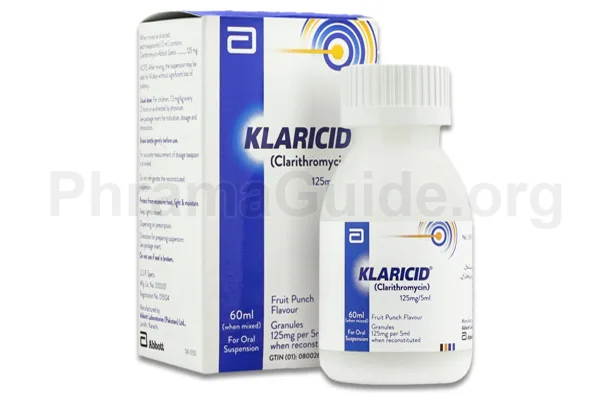Klaricid syrup is a medication that belongs to the class of antibiotics known as macrolides. Klaricid Syrup is primarily used for the treatment of various bacterial infections caused by susceptible organisms. It is mostly recommended for children and adults where a low dose of medicine is needed. The following are some common uses of Klaricid Syrup:
- Respiratory tract infections: Klaricid syrup is commonly used to treat respiratory tract infections in children, such as:
- Acute otitis media (middle ear infection)
- Acute Bronchitis
- Sinusitis (inflammation of the sinuses)
- Pharyngitis (sore throat) or tonsillitis
- Community-acquired pneumonia
- Skin and soft Tissue Infections: Klaricid syrup can also be used to treat certain skin and soft tissue infections in children, including:
- Cellulitis (skin infection)
- Impetigo (bacterial skin infection characterized by blisters or sores)
- Erysipelas (superficial skin infection)
- Mycobacterial infections: In some cases, Klaricid syrup may be prescribed for the treatment of mycobacterial infections in children, such as:
- Mycobacterium avium complex (MAC) infection in patients with human immunodeficiency virus (HIV)
- Disseminated Mycobacterium chelonae or Mycobacterium abscessus infection
Off-label Uses of Klaricid Syrup
- Helicobacter pylori Infection: in some cases, healthcare professionals may use Klaricid syrup off-label for H. pylori eradication in children.
- Atypical Infections: Klaricid has activity against certain atypical bacteria, such as Mycoplasma pneumoniae and Chlamydia pneumoniae. While the use of Klaricid syrup for these infections may not be specifically approved, healthcare professionals may consider off-label use in certain circumstances, such as when other treatment options are limited or when the infection is suspected based on clinical judgment.
- Acute Exacerbations of Chronic Bronchitis: Although Klaricid is approved for the treatment of certain respiratory infections, such as community-acquired pneumonia, its use in the treatment of acute exacerbations of chronic bronchitis (AECB) may be considered off-label. AECB refers to a sudden worsening of symptoms in individuals with chronic bronchitis, and Klaricid may be used in certain cases to target the bacterial component of the exacerbation.
- Prophylaxis in Certain Conditions: In specific situations, Klaricid syrup may be used off-label as prophylaxis (preventive treatment) for certain infections. For example, in children with a history of recurrent otitis media (middle ear infection) or respiratory tract infections, Klaricid may be prescribed intermittently to help prevent future episodes.

What is Klaricid?
Klaricid Syrup is one of the leading brands of Clarithromycin in oral liquid form, manufactured and marketed by Abbott Laboratories (Pakistan) Ltd.
Klaricid Alternatives : Other Clarithromycin Brands
The following are some alternative brands of Klaricid Syrup and their manufacturers.
- Claritek : Getz Pharmaceuticals, Pakistan.
- E-Clar : Tabros Pharmaceuticals, Pakistan.
- Rithmo : Sami Pharmaceuticals, Pakistan.
- Klaribact : Merck (Pvt) Ltd.
- Maclacin : Bosch Pharmaceuticals, Pakistan
- Canter : Indus Pharmaceuticals, Pakistan.
- Clarion : Ferozsons Laboratories, Pakistan.
- Larith : Genix Pharmaceuticals, Pakistan.
- Megaklar : Barret Hodgson, Pakistan.
- Clacin : Werrick Pharmaceuticals, Pakistan.
Klaricid : Available Formulations and Strengths
Presently, Klaricid is available in Syrup, Tablet, and Injection forms.
Klaricid Syrup : 125mg/5ml strength.
Klaricid Tablet : 250mg, and 500mg strengths.
Klaricid XL Tablet : 500mg strength.
Klaricid IV Injection : 500/vial (10ml) strength.
Who Should Not Use Klaricid?
Klaricid syrup has certain contraindications, which are situations where the use of Klaricid is not recommended due to potential risks or adverse effects.
Hypersensitivity: Individuals who have a known hypersensitivity or allergy to Klaricid or any other macrolide antibiotics should not use Klaricid syrup.
Concomitant Use with Cisapride, Pimozide, or Terfenadine: Klaricid should not be used concurrently with cisapride, pimozide, or terfenadine due to the potential for serious cardiac effects, including QT prolongation and arrhythmias.
Previous History of QT Prolongation: Individuals with a history of QT interval prolongation, ventricular arrhythmias, or significant cardiac conduction abnormalities should avoid Klaricid syrup.
Severe Hepatic Impairment: Klaricid is primarily metabolized by the liver, and individuals with severe hepatic impairment may have difficulty clearing the medication from their system. Therefore, it is generally contraindicated in such cases.
Concomitant Use with Colchicine in Renally Impaired Patients: Klaricid should not be used in combination with colchicine in patients with renal impairment due to the risk of colchicine toxicity.
Porphyria: Klaricid syrup is contraindicated in individuals with a history of porphyria, a group of rare genetic disorders that affect the production of heme, an essential component of hemoglobin.
What is the Recommended Daily Dosage of Klaricid Syrup?
For pediatric patients, the usual recommended dose of Klaricid syrup is:
- Klaricid Syrup Dose for Respiratory Tract Infections:
- Acute otitis media:
15 mg/kg/day divided into two doses, up to a maximum of 1 gram per day. - Pharyngitis/tonsillitis:
15 mg/kg/day divided into two doses, up to a maximum of 500 mg per day. - Sinusitis:
15 mg/kg/day divided into two doses, up to a maximum of 500 mg per day. - Community-acquired pneumonia:
15 mg/kg/day divided into two doses, up to a maximum of 1 gram per day.
- Acute otitis media:
- Klaricid Syrup Dose for Skin and Soft Tissue Infections:
- Cellulitis/impetigo/erysipelas:
15 mg/kg/day divided into two doses, up to a maximum of 500 mg per day.
- Cellulitis/impetigo/erysipelas:
- Klaricid Syrup Dose for Mycobacterial infections (off-label use):
- Dosage may vary depending on the specific infection and individual patient factors. It is determined on a case-by-case basis by the treating healthcare professional.
How Klaricid Works?
Klaricid works by binding to the 50S subunit of the bacterial ribosome, which is a crucial component involved in protein synthesis. By binding to the ribosome, it prevents the formation of functional peptide chains, thereby inhibiting the synthesis of essential bacterial proteins. This disruption in protein synthesis impairs bacterial growth and reproduction.
Related Links:

Leave A Comment